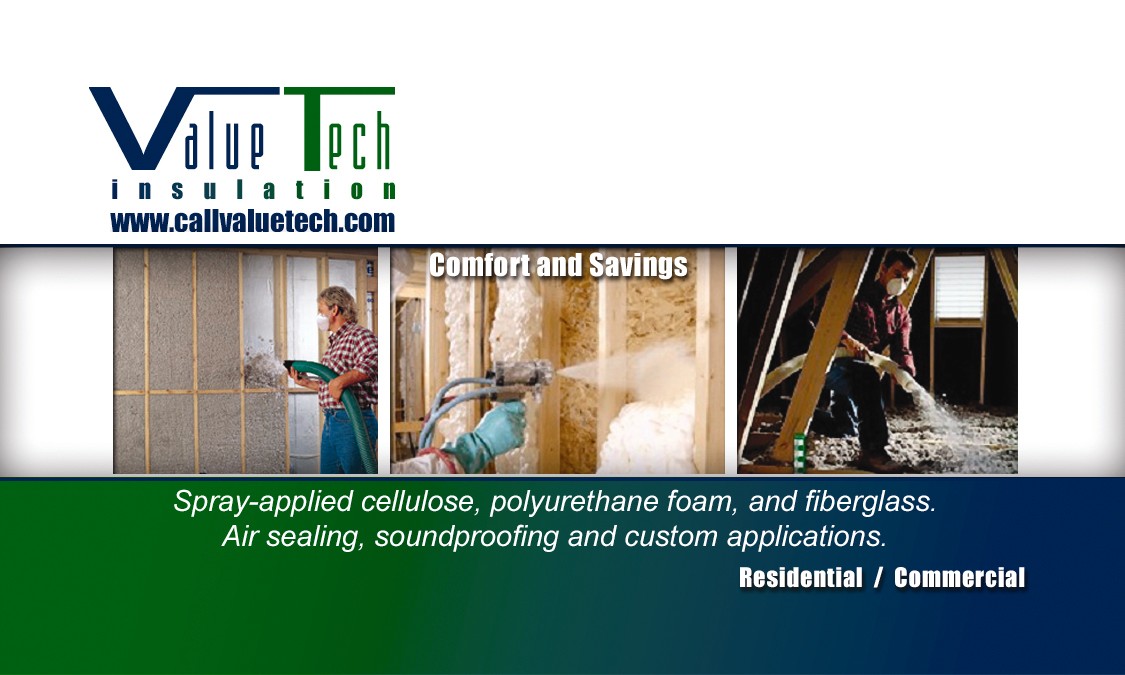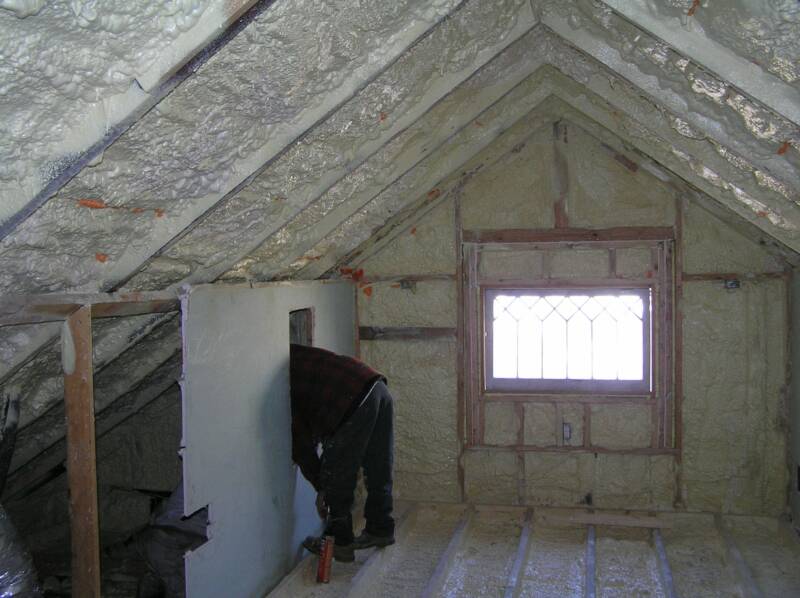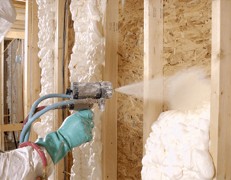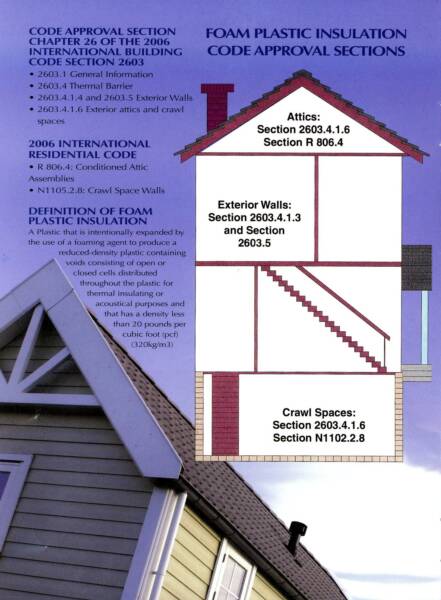

Click here

Helping the "Building Green" revolution of energy savings for the planet and the pocket.
See U.S. Government "Green Home" building programs.
Click here
See History Channel's video on foam "Modern Marvel" ( 23 MB download)

Serving Metro Atlanta and the Southeast U.S.
770-981-9090
Fax: 484-991-5162
Free estimates
Email: info@callvaluetech.com
Some selected Code Requirements
Back to TOP << click here
Back to foam page on OPEN vs. CLOSED cell foam << click here
Although most counties in Georgia may not require compliance with ICC codes, the International Construction Codes (ICC) require an impermeable (condensation) barrier directly below (as well as above) the roof decking when Icynene (and generic open-cell foam) products are used in new construction. Some codes in new construction also require a 15 minute fire barrier between the foam and the attic air. (Note, in paragraph #4 of the code below, that in colder than Georgia temperatures an impermeable barrier is also required “in direct contact with the underside of the insulation”-- which would sandwich the Open-cell foam between two impermeable layers-- one on the underside of the decking surface, and one beneath the foam.)
In an excerpt from the 2007 International Residential Code, Chapter 8, Section R806.4, regarding “Unvented Attic Assemblies” (found on page 69), with specific regard to condensation, it states the following:
R806.4 Unvented attic assemblies. Unvented attic assemblies (spaces between the ceiling joists of the top story and the roof rafters) shall be permitted if all the following conditions are met:
1. The unvented attic space is completely contained within the building thermal envelope.
2. No interior vapor retarders are installed on the ceiling side (attic floor) of the unvented attic assembly. [Note: This
3. Where wood shingles or shakes are used, a minimum ¼ inch (6 mm) vented air space separates the shingles or
shakes and the roofing underlayment above the structural sheathing.
4. In climate zones 5, 6, 7 and 8 [colder than Georgia], any air-impermeable insulation shall be a vapor retarder, or
shall have a vapor retarder coating or covering in direct contact with the underside of the insulation.
5. Either Items a, b or c [below] shall be met, depending on the air permeability of the insulation directly under the
below the structural sheathing, rigid board or sheet insulation shall be installed directly above the structural roof
sheathing [between the shingles and the decking] as specified in Table R806.4 for condensation control.
shall be applied in direct contact to the underside of the structural roof sheathing as specified in Table R806.4 for
condensation control. The air-permeable insulation [open-cell] shall be installed directly under the air-
NOTE: Closed-cell foam is being prescribed for condensation control by the ICC code above. As in #4, above, Closed-cell foam is actually being used as the vapor retarder, never the cause of condensation as Open-cell advocates sometimes suggest, when they do not themselves offer the Closed-cell product. Obviously the ICC disagrees with their dubious marketing strategy since the logic is exactly the opposite.
[Notes, such as this, as well as bold and underlining are added by the Value Tech editor.]
Of course if you have to spray the attic twice (once with the foam and once with the vapor barrier) you increase the cost. The same is true for the 15 minute fire barrier that some Inspectors require for Open-cell foam. Thus with the Open cell, you might have to have three applications of material: FIRST, in 5c above, you would have to apply a vapor barrier (such as a thin flash-coat of Closed-cell foam) in direct contact to the underside of the structural roof and SECOND you would apply the Open-cell underneath that, and THIRD you may then have to have the 15 minute fire barrier that some Inspectors require for Open-cell foam )—driving up material and labor costs. This is never the case with Value Tech's Closed-cell foam (see 5a). Remember, however, that both open-cell and closed-cell foam have greater fire-retardent properties than the wood material that they are sprayed on, and that often the home owner is left to make the judgement call regarding the fire barrier when using Open-cell foam, in both new and existing homes (that is, inspections are not required in existing homes, and not all inspectors require compliance with these codes in new construction).
The vapor barrier is, however, a real issue when choosing Open-cell foam. Whether required by code or not, the inability of Open-cell foam to completely stop air flow through it means that in some locations there is a chance of condesation within the foam; that is, if you do not isolate the Open-cell foam from the wood material it is sprayed on with a vapor barrier (like closed-cell foam). That wood will most often be a different temperature than the air you are trying to keep back from it (the reason for insulation in the first place), thus risking condesation at the point where the two temperatures collide. Thus, this means that the very reason (impermeability) promoters of Icynene® sometimes use to advocate it over Closed-cell foam is the very same reason, according to the science behind this code, not to use it. Contact Value Tech Insulation, LLC, to see which foam best matches your needs and your budget, so that you can begin saving energy costs right away. In some situations we may recommend Open-cell (such as Icynene®), and in others Closed-cell. We provide both. For more on the differences see our web page discussion of them at www.callvaluetech.com/OpenCell-ClosedCell.html
NOTE: Because of its permeability and the possibillity of condensation and mold formation within it, like fiberglass Open-cell foam (such as Icynene®) should NEVER be used in a crawl space.
Click here to enlarge,
and then click again to enlarge once again if necessary.
SOME CONSIDERATIONS REGUARDING
ONE OF THE ICC CODE REQUIREMENTS

